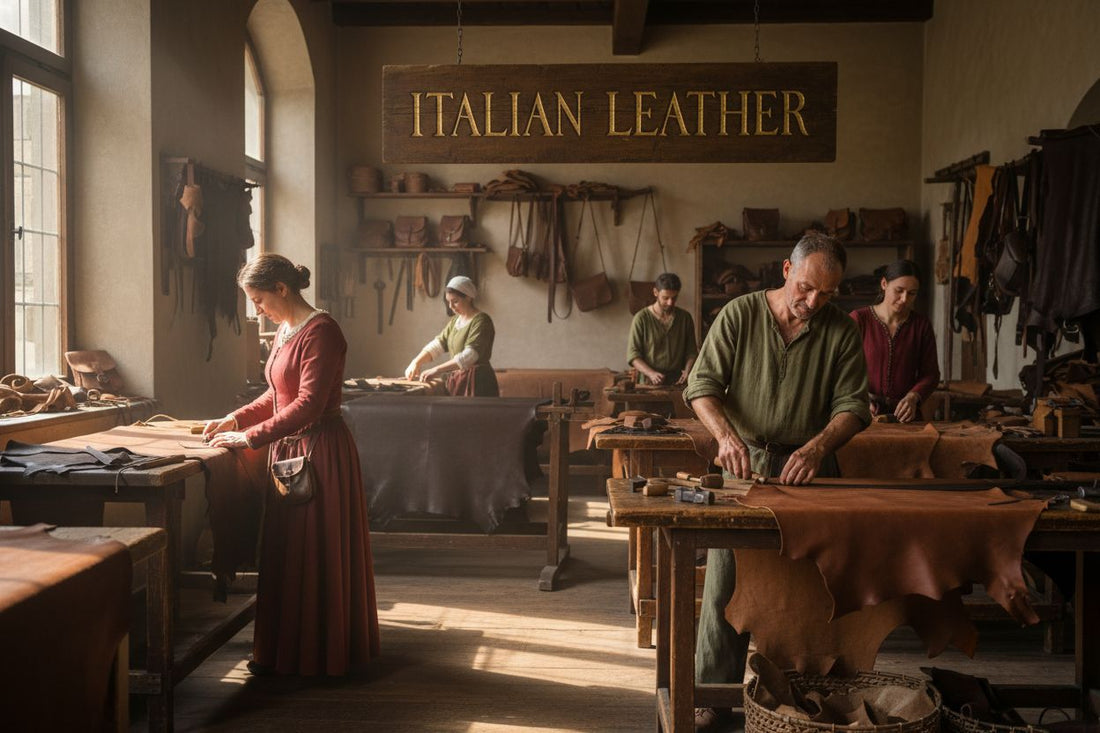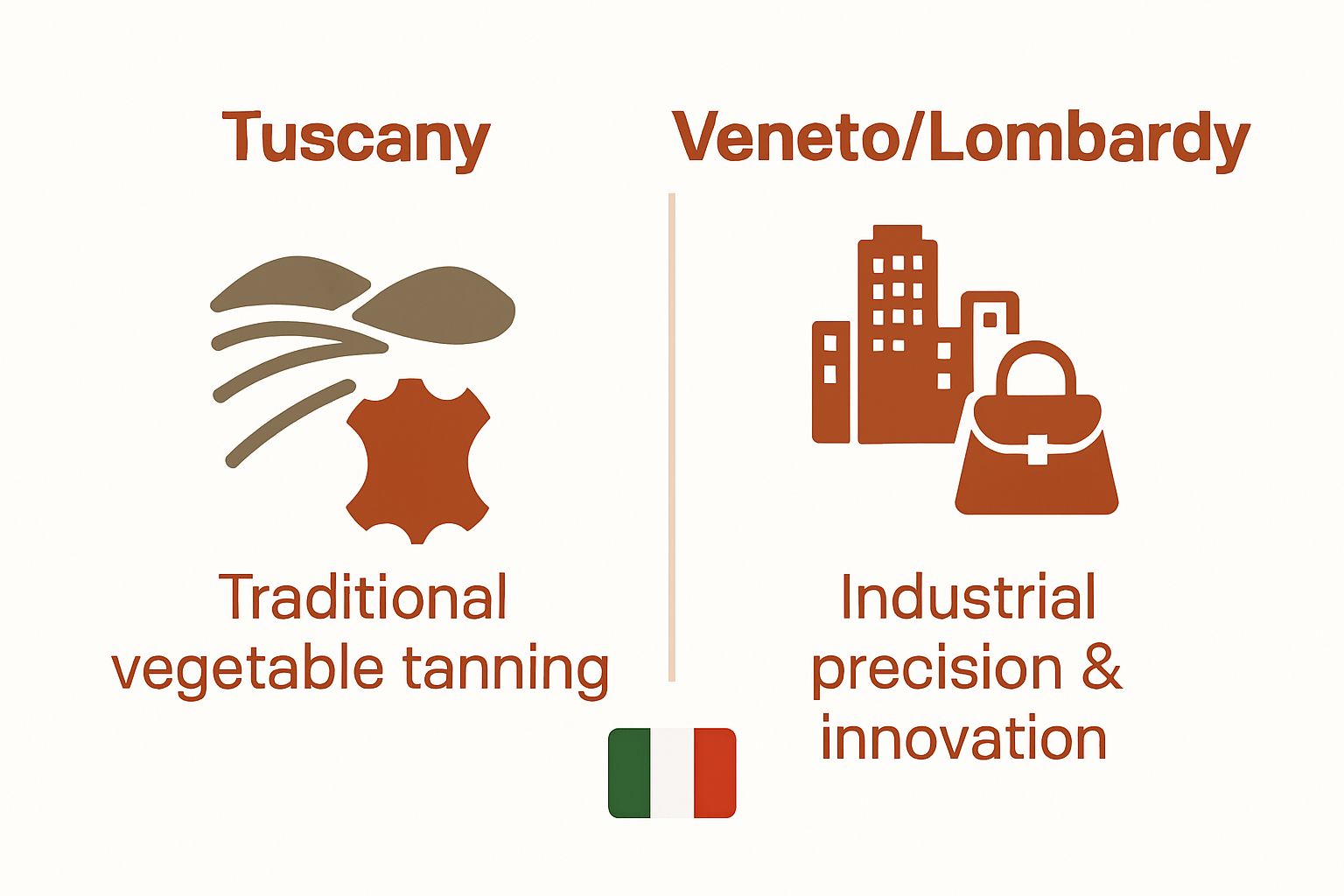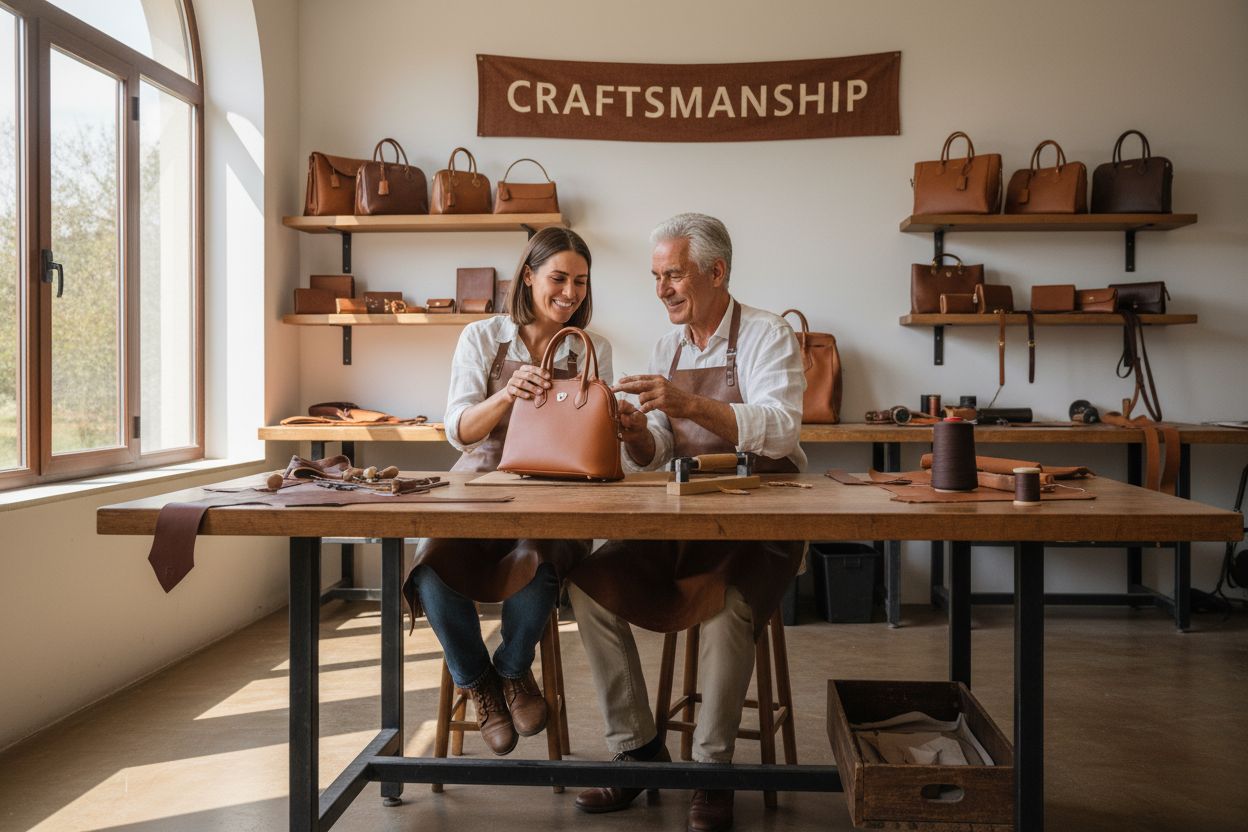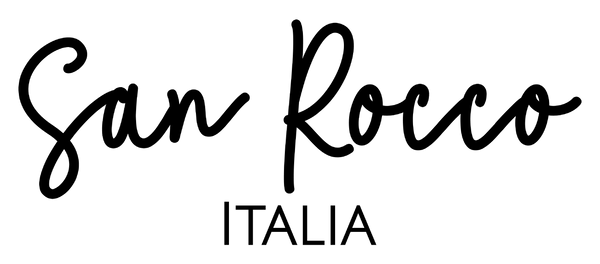
Understanding the History of Italian Leather Craftsmanship
Share
Italian leather is famous for its extraordinary quality and timeless style. Some say its secret lies in centuries of careful craft, yet over 70 percent of the world’s luxury leather goods come from just a handful of Italian regions. That might sound like tradition rules everything, but today, these same artisans are rewriting the rules with sustainable methods and cutting-edge technology that most people never see coming.
Table of Contents
- The Origins Of Italian Leather: A Timeless Tradition
- Key Regions And Their Unique Contributions To Leather Craft
- The Role Of Artisanal Techniques In Shaping Quality
- Why Italian Leather Is Synonymous With Luxury And Durability
- Modern Trends And Sustainability In Italian Leather Production
Quick Summary
| Takeaway | Explanation |
|---|---|
| Italian leather has deep historical roots. | The craftsmanship dates back to medieval times, particularly in Tuscany and Venice, where unique tanning techniques were established. |
| Quality hinges on artisan techniques. | The transformation of raw hides into leather involves meticulous artisanal skills, ensuring each piece meets high standards of quality. |
| Tuscany is the heart of leather innovation. | Renowned for exceptional vegetable tanning methods, Tuscany produces durable leather, emphasising meticulous attention to sustainability and quality. |
| Modern practices prioritise sustainability. | The industry is integrating eco-friendly processes, such as water-efficient tanning and recycling waste, to minimise environmental impact. |
| Technological advancements complement tradition. | Modern technologies are enhancing traditional craftsmanship, allowing for improved efficiency and transparency in the production of leather goods. |
The Origins of Italian Leather: A Timeless Tradition
The history of Italian leather craftsmanship represents an extraordinary narrative of cultural heritage, artisanal skill, and remarkable innovation that stretches back centuries. From the medieval tanneries of Tuscany to the sophisticated workshops of Milan, Italian leather production has evolved into a globally recognised symbol of exceptional quality and sophisticated design.
The Roots of Italian Leather Production
The foundations of Italian leather craftsmanship can be traced back to the medieval period, particularly in regions like Florence and Venice, where strategic trade routes and advanced tanning techniques converged. Skilled artisans developed intricate methods for transforming raw animal hides into supple, durable leather, establishing techniques that would become legendary. Research from the Italian Leather Consortium indicates that these early craftsmen developed unique preservation and treatment processes that significantly distinguished Italian leather from other European productions.
Cultural and Economic Significance
Leather craftsmanship in Italy was never merely an industry but a profound cultural expression. Families passed down intricate skills from generation to generation, creating a living tradition of exceptional craftsmanship. The economic importance of leather production grew dramatically during the Renaissance, with Italian leather goods becoming coveted luxury items across European courts. Notably, regions like Tuscany developed specialised techniques that transformed leather from a mere functional material into an art form.
Interested readers can read more about our guide on Italian leather craftsmanship to explore the nuanced world of this remarkable tradition. By understanding its rich history, we gain deeper appreciation for the meticulous skill and cultural heritage embedded in every carefully crafted leather piece.
Key Regions and Their Unique Contributions to Leather Craft
Italy’s leather craftsmanship is not a monolithic tradition but a rich tapestry of regional specialities, each contributing distinctive techniques, styles, and innovations to the broader national heritage. Understanding these regional nuances reveals the extraordinary depth and complexity of Italian leather production.
Tuscany: The Epicentre of Leather Innovation
Tuscany, particularly the area around Florence, stands as the undisputed heartland of Italian leather production. Research from the Tuscany Leather Consortium demonstrates that this region has developed some of the most sophisticated leather processing techniques in the world. Florentine artisans are renowned for their exceptional vegetable tanning methods, which produce leather with remarkable durability and a unique, rich patina that improves with age.
Key characteristics of Tuscan leather craftsmanship include:
- Meticulous attention to natural tanning processes
- Emphasis on environmentally sustainable production methods
- Exceptional colour manipulation and finishing techniques
Veneto and Lombardy: Industrial Excellence and Haute Craftsmanship
While Tuscany represents artisanal tradition, the northern regions of Veneto and Lombardy epitomise industrial precision and high-end leather manufacturing. These areas, including cities like Venice and Milan, have transformed leather production into a sophisticated industrial art form. Here, technological innovation meets traditional craftsmanship, creating leather goods that are both technologically advanced and aesthetically sublime.
The following table compares the distinctive contributions of major Italian leather-producing regions, helping readers quickly grasp regional specialities and strengths.
| Region | Notable Cities | Distinctive Techniques & Features |
|---|---|---|
| Tuscany | Florence | Exceptional vegetable tanning, sustainability focus, rich patina |
| Veneto | Venice | Industrial precision, blending technology with tradition |
| Lombardy | Milan | High-end manufacturing, technologically advanced processes |
Learn more about our exploration of Italian leather manufacturing techniques to gain deeper insights into these remarkable regional variations. Each region tells a unique story of skill, innovation, and cultural pride through its leather crafting traditions.

The Role of Artisanal Techniques in Shaping Quality
Artisanal techniques represent the fundamental cornerstone of Italian leather craftsmanship, transforming raw materials into extraordinary products that embody centuries of accumulated knowledge and skill. These time-honoured methods go far beyond mere manufacturing processes, representing a profound cultural expression of creativity and precision.
Traditional Leather Preparation Methods
The preparation of leather involves intricate techniques passed down through generations of craftsmen. Research from the European Traditional Crafts Association reveals that traditional preparation involves multiple sophisticated stages, each requiring exceptional skill and intimate understanding of material properties. Skilled artisans carefully select raw hides, meticulously inspect their quality, and apply specific treatment techniques that enhance the leather’s natural characteristics.
Key aspects of traditional leather preparation include:
- Careful hide selection based on texture and grain quality
- Precise cleaning and initial treatment processes
- Nuanced understanding of different animal hide characteristics
Handcrafting Techniques and Quality Control
Handcrafting represents the pinnacle of Italian leather production, where individual artisans apply generations of accumulated expertise to transform leather into exceptional products. Every stitch, cut, and finish is executed with remarkable precision, ensuring each piece meets extraordinarily high standards. These techniques involve manual interventions that machine production cannot replicate, creating products with unique character and unparalleled quality.
Explore our comprehensive guide to Italian leather manufacturing techniques to gain deeper insights into these remarkable traditional methods that continue to define global leather craftsmanship standards.
Why Italian Leather is Synonymous with Luxury and Durability
Italian leather represents the pinnacle of global leather production, distinguished by its exceptional quality, sophisticated manufacturing processes, and an unparalleled commitment to craftsmanship that transcends mere material production. This reputation emerges from a complex interplay of historical expertise, technological innovation, and an unwavering dedication to preserving traditional artisanal techniques.
Material Selection and Processing Excellence
Research from the Tannery Magazine reveals that Italian leather’s superiority begins with meticulous raw material selection. Craftsmen choose only the highest quality animal hides, carefully examining each for structural integrity, natural grain, and potential for exceptional finishing. The processing techniques employed transform these carefully selected materials into leather with remarkable characteristics:
- Remarkable tensile strength
- Exceptional natural breathability
- Enhanced resistance to wear and aging
- Ability to develop a rich, sophisticated patina over time
Technological Innovation Meets Traditional Craftsmanship
The unique status of Italian leather stems from its ability to harmonise cutting-edge technological processes with generations-old artisanal knowledge. Modern tanning technologies are combined with hand-finishing techniques that have been perfected over centuries, creating leather products that are simultaneously innovative and deeply traditional. This approach ensures that each piece maintains exceptional quality while reflecting the nuanced skills of its creators.
Learn more about investing in Italian leather quality to understand why discerning consumers and luxury brands worldwide consistently choose these extraordinary leather goods. The combination of superior materials, expert craftsmanship, and technological precision makes Italian leather an enduring symbol of luxury and durability.
Modern Trends and Sustainability in Italian Leather Production
The Italian leather industry stands at a crucial intersection of tradition and innovation, responding proactively to global environmental challenges while maintaining its reputation for exceptional craftsmanship. Contemporary leather production increasingly prioritises sustainable practices, technological advancement, and ethical manufacturing processes that respect both cultural heritage and environmental responsibility.
Ecological Transformation in Leather Manufacturing
Research from the European Sustainable Leather Foundation demonstrates that Italian leather manufacturers are pioneering groundbreaking ecological approaches. The industry has substantially transformed its traditional processes, implementing comprehensive strategies that minimise environmental impact while preserving the exceptional quality synonymous with Italian leather production.
Key sustainable innovations include:
- Water-efficient tanning processes
- Utilisation of vegetable-based and chrome-free tanning techniques
- Recycling and repurposing leather production waste
- Implementing carbon-neutral manufacturing strategies
Technology and Ethical Production
Modern Italian leather production integrates sophisticated digital technologies with time-honoured craftsmanship, creating a sophisticated approach to manufacturing that enhances both efficiency and product quality. Advanced tracking systems now enable complete transparency in the production process, allowing consumers to understand the precise origins and manufacturing conditions of their leather goods.
Explore our insights into the future of the Italian leather industry to understand how traditional craftsmanship is evolving in response to contemporary global challenges. The ongoing transformation represents a commitment to preserving both environmental integrity and the exceptional artisanal legacy of Italian leather production.
This table summarises traditional and modern sustainable innovations in Italian leather production, highlighting how eco-friendly practices are integrated with artisanal techniques.
| Practice Area | Traditional Approach | Modern Sustainable Innovations |
|---|---|---|
| Tanning Processes | Vegetable tanning using natural agents | Water-efficient and chrome-free tanning |
| Material Sourcing | Careful selection of animal hides | Focus on sustainable and ethical sourcing |
| Waste Management | Minimal; limited recycling | Recycling and repurposing of production waste |
| Energy Use | Conventional energy sources | Carbon-neutral manufacturing strategies |
| Production Transparency | Family-run, limited external insight | Advanced digital tracking and full process transparency |

Experience True Italian Craftsmanship Today
After exploring the origins and artisanal techniques behind Italian leather, you may find yourself searching for authenticity and lasting quality in your everyday accessories. Mass production, synthetic materials, and imitation finishes often leave consumers disappointed, longing for genuine luxury and timeless design. For those who appreciate meticulous skill, traditional vegetable tanning and the pride of Florentine handcrafting, there is a real solution to these challenges.

Discover the difference with San Rocco Italia, where every handbag and leather accessory is crafted in Italy using premium full-grain leather by skilled female artisans. Our collection embodies the history and quality highlighted in the article, bringing you pieces that will develop a beautiful patina and last for generations. Do not settle for less. Bring home the artistry of true Italian leather and start your journey today at San Rocco Italia. For those wanting to learn more about the craftsmanship in each piece, visit our blog section for further insights. Embrace quality that speaks for itself and shop now before these handmade treasures are gone.
Frequently Asked Questions
What is the historical significance of Italian leather craftsmanship?
Italian leather craftsmanship holds profound historical significance as it represents a centuries-old tradition of artisanal skill and cultural heritage. Explore how the craftsmanship flourished during the medieval period, particularly in key cities, and discover the techniques that set it apart from other leather production methods.
How were early Italian leather production techniques developed?
Early Italian leather production techniques developed through skilled artisans who merged trade routes with innovative tanning methods. To understand these origins, research the various processes they created, which still influence contemporary craftsmanship today.
What materials are traditionally used in Italian leather production?
Italian leather production traditionally utilises high-quality animal hides, specifically chosen for their natural grain and structural integrity. Investigate the types of raw materials utilised and the selection criteria that artisans employ during the preparation phase.
How does the Renaissance period impact the evolution of Italian leather craftsmanship?
The Renaissance period significantly impacted Italian leather craftsmanship by elevating it from a mere industry to a luxury art form. Study how this cultural shift led to increased demand for leather goods and refined production techniques that set standards for quality.
What role does tradition play in the quality of Italian leather today?
Tradition plays a critical role in maintaining the quality of Italian leather through time-honoured techniques and craftsmanship passed down generationally. Embrace these techniques by learning from artisans or workshops that continue to practice these age-old skills, ensuring each product’s uniqueness and durability.
Recommended
- Understanding Italian Leather Craftsmanship: Timeless Quality – San Rocco Italia
- Understanding the Benefits of Italian Leather Quality – San Rocco Italia
- Understanding How Italian Leather is Made: A Comprehensive Guide – San Rocco Italia
- Why Invest in Italian Leather: Understanding its Value – San Rocco Italia


